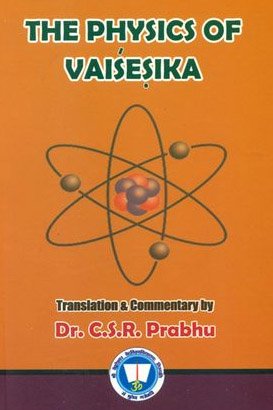Nyayakandali, Nyaya-kandali, Nyāyakaṇḍalī: 5 definitions
Introduction:
Nyayakandali means something in Hinduism, Sanskrit. If you want to know the exact meaning, history, etymology or English translation of this term then check out the descriptions on this page. Add your comment or reference to a book if you want to contribute to this summary article.
In Hinduism
Yoga (school of philosophy)
Source: Google Books: Yoga PowersIn his Nyāyakaṇḍalī, Śrīdhara provides the conceptual bridge between normal perception, yogi perception, and the power of entering into a foreign body, which was in fact the forte of yogis in epic and medieval narratives.

Yoga is originally considered a branch of Hindu philosophy (astika), but both ancient and modern Yoga combine the physical, mental and spiritual. Yoga teaches various physical techniques also known as āsanas (postures), used for various purposes (eg., meditation, contemplation, relaxation).
Vaisheshika (school of philosophy)
Source: Shodhganga: A study of Nyāya-vaiśeṣika categories (vaisesika)Nyāyakaṇḍalī (न्यायकण्डली).—Another important commentary on Praśastapāda’s Bhāṣya is Nyāyakaṇḍalī written by Śrīdhara. Among the commentaries on Padārthadharmasaṃgraha, “Nyāya-Kaṇḍalī of Śrīdhara on account of its simplicity of style and elaborate nature of exposition is probably the best for a modern student of Vaiśeṣika”.

Vaisheshika (वैशेषिक, vaiśeṣika) refers to a school of orthodox Hindu philosophy (astika), drawing its subject-matter from the Upanishads. Vaisheshika deals with subjects such as logic, epistemology, philosophy and expounds concepts similar to Buddhism in nature
General definition (in Hinduism)
Source: Wisdom Library: Hinduism
The Nyāyakaṇḍalī (न्यायकण्डली) by Śrīdhara is a 10th century Sanskrit commentary on the Praśastapādabhāṣya of Praśastapādācārya, wich is itself a commentary on Kaṇāda’s Vaiśeṣikasūtra. The Vaiśeṣikasūtra expounds the philosophy of the Vaiśeṣika, one of the six orthodox schools of Hindu philosophy dealing with subjects such as Metaphysics, Logic and Epistemology..
Languages of India and abroad
Sanskrit dictionary
Source: Cologne Digital Sanskrit Dictionaries: Aufrecht Catalogus Catalogorum1) Nyāyakandalī (न्यायकन्दली) as mentioned in Aufrecht’s Catalogus Catalogorum:—a
—[commentary] on the Padārthadharmasaṃgraha, composed by Śrīdhara in 991. Kh. 88. Report. Xxv. Cxliii. L. 2589. Peters. 3, 26^a. 272. Bp. 6. 313.
—[commentary] by Prativādibhayaṃkara. Rice. 112.
2) Nyāyakandalī (न्यायकन्दली):—
—[commentary] Pañjikā by Rājaśekhara Sūri. Peters. 3, 272.
3) Nyāyakandalī (न्यायकन्दली):—a
—[commentary] on the Padārthadharmasaṃgraha, by Śrīdhara, son of Baladeva. L. 4186.
—[commentary] Padārthapraveśa by the same. Stein 148.
—[commentary] by Padmanābha, son of Balabhadra. See Praśastapādabhāṣya in the Vizianagram Sanskrit Series, Preface p. 4.
—[commentary] Pañjikā by Rājaśekhara. Peters. 3, 272.
Nyāyakandalī (न्यायकन्दली):—[=ny-āya-kandalī] [from ny-āya] f. Name of [work]
Sanskrit, also spelled संस्कृतम् (saṃskṛtam), is an ancient language of India commonly seen as the grandmother of the Indo-European language family (even English!). Closely allied with Prakrit and Pali, Sanskrit is more exhaustive in both grammar and terms and has the most extensive collection of literature in the world, greatly surpassing its sister-languages Greek and Latin.
See also (Relevant definitions)
Partial matches: Nyaya, Kandali, Kamtali.
Full-text: Tattvasamvadini, Pandudasa, Tattvaprabodha, Jagadanandana, Samgrahatika, Rajashekhara suri, Shridhara, Kandalikara, Dharmottaracarya, Advaitasiddhi, Shridhara bhatta, Nyayakanika, Avatana, Vriksha, Oshadhi, Vanaspati, Padartha, Prashastapada, Lata.
Relevant text
Search found 14 books and stories containing Nyayakandali, Nyaya-kandali, Nyāya-kaṇḍalī, Nyāya-kandalī, Nyāyakaṇḍalī, Nyāyakandalī; (plurals include: Nyayakandalis, kandalis, kaṇḍalīs, kandalīs, Nyāyakaṇḍalīs, Nyāyakandalīs). You can also click to the full overview containing English textual excerpts. Below are direct links for the most relevant articles:
Nyaya-Vaisheshika categories (Study) (by Diptimani Goswami)
Historical Survey of Vaiśeṣika System < [Chapter 1 - Introduction]
Mokṣa or Liberation < [Chapter 2 - Salient features of Nyāya-Vaiśeṣika System]
The Vaiśeṣika theory of Universal and the Conflict with the Buddhists < [Chapter 5 - Sāmānya and Viśeṣa]
Padarthadharmasamgraha and Nyayakandali (by Ganganatha Jha)
Text 51 < [Chapter 6a - On Qualities]
Text 29 < [Chapter 3 - Similarities and Dissimilarities among Categories]
Text 55 < [Chapter 6a - On Qualities]
A History of Indian Philosophy Volume 2 (by Surendranath Dasgupta)
Part 8 - Maṇḍana, Sureśvara and Viśvarūpa < [Chapter XI - The Śaṅkara School of Vedānta (continued)]
Part 5 - The Foetus and the Subtle Body < [Chapter XIII - Speculations in the Medical Schools]
Part 16 - Springs of action in the Caraka-samhitā < [Chapter XIII - Speculations in the Medical Schools]
The validity of Anumana (inference) in Nyaya system (by Babu C. D)
Preceptors of Advaita (by T. M. P. Mahadevan)
A History of Indian Philosophy Volume 1 (by Surendranath Dasgupta)
Part 8 - The main doctrine of the Nyaya-Vaiśeṣika Philosophy < [Chapter VIII - The Nyāya-Vaiśeṣika Philosophy]
Part 13 - The Nyāya-Vaiśeṣika Physics < [Chapter VIII - The Nyāya-Vaiśeṣika Philosophy]
Part 18 - Upamāna and Sabda < [Chapter VIII - The Nyāya-Vaiśeṣika Philosophy]